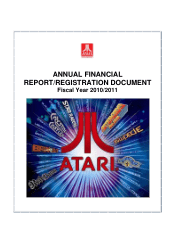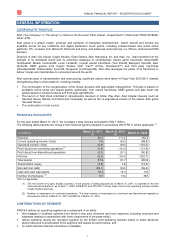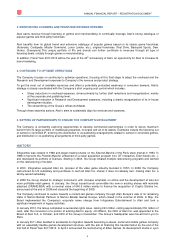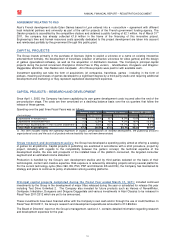Atari 2011 Annual Report Download - page 7
Download and view the complete annual report
Please find page 7 of the 2011 Atari annual report below. You can navigate through the pages in the report by either clicking on the pages listed below, or by using the keyword search tool below to find specific information within the annual report.
ANNUAL FINANCIAL REPORT – REGISTRATION DOCUMENT
7
(France). In June, the workforce was reduced to approximately 30 employees, adjusting costs to the size of the business
and its revenues. At the end of May, the Group announced that it had sold Cryptic Studios to the Chinese company
Perfect World for €35 million. The closing of this transaction is still pending. In June, the Company and BlueBay agreed
the extension of a credit facility of €49 million to December 30, 2011.
THE MARKET FOR INTERACTIVE ENTERTAINMENT SOFTWARE
The interactive entertainment software industry primarily comprises software for dedicated game consoles or platforms
(such as PlayStation 3, Xbox 360 and Wii), handhelds (such as Nintendo DS and DSi and Sony PSP) and PCs.
Publishers of video game software include console manufacturers, which publish games for their own consoles, or "first-
party publishers", and third-party publishers, such as Atari, whose primary role is to develop, publish and distribute video
game software for existing platforms. The online casual and social gaming segment is the fastest growing part of the
video game market. Additionally, the use of wireless devices (such as mobile phones and smartphones) as a gaming
platform, known as "mobile gaming", is growing rapidly.
The videogame market has been generally affected by the difficult economic situation, specifically depleted consumer
spending, ongoing since late 2008. According to International Development Group (IDG), an independent company
specializing in the analysis of statistical data in the fields of technology, media, etc., hardware and software revenues as
declined in calendar year 2010 and are expected to further decline in 2011 by 11% and 15% respectively in the US from
2010 and 11% and 13% respectively in Europe from 2010.
THE CONSOLE AND HANDHELD MARKET
Console technology has evolved considerably since Nintendo brought out its first generation of modern game consoles in
1985. Console manufacturers generally release a new game console with more advanced technology every four or five
years. So-called hand-held consoles have also evolved since they first appeared in the market, although the life-span of
those products is generally longer (4 to 5 years for home devices, versus 10 years for GameBoy and 6 years for
GameBoy Advance).
Sony was the first manufacturer to bring out a new generation console when it released its PlayStation 2 platform in
2000. The following year, Nintendo came out with the GameCube and Game Boy Advance. That generation of consoles
also featured the market entry of Microsoft, with the Xbox console.
Near the end of 2005, the next generation of consoles hit the market when Microsoft brought out its Xbox 360 in a
segment long dominated by Sony’s Playstation 2 (first sold in 2000). Nintendo’s Wii console came out in December
2006, about the same time as Sony’s PS3. These “nextgen” models represented a significant advance in video game
technology, with the potential of appealing to a wider audience. While Microsoft and Sony added online capabilities to
their consoles, motion sensors (PlayStation Move, PS Vita, Wii U and Kinect) and more power to create a more realistic
and advanced game experience (along with video entertainment capacity with the new HD laser disk players), Nintendo
developed a new gaming technique by replacing the traditional gamepads with remote controls and motion sensors.
As the technology has improved, competition has intensified and consumers have become more selective, causing the
video game industry to become increasingly dependent on hit products.
The portable console segment is also innovating, with manufacturers offering more sophisticated systems such as the
Sony PSP and the Nintendo DS, DSi and 3DS devices, which have many features and options as well as a wide range of
gaming functions, in addition to wireless connection capabilities.
PERSONAL COMPUTERS
PC technology has been evolving in a more straight-line fashion than home and portable game consoles.
Improvements in microprocessors, graphic cards, hard disk capacity, operating systems and memory size have
contributed significantly to the ability of computers to act as video game platforms.
Technological advances have made it possible for developers to produce video games for PC with a more sophisticated
gameplay and leading-edge graphics.
The fact that the market for PC games is not repeatedly affected by technology cycles and that publishers do not have to
pay royalties and high manufacturing costs for PC products makes this an attractive market for makers of video games.
However, retailers have reduced the shelf space allocated to PC products. This trend could be offset, at least in part, by
an increased demand for Massively Multiplayer Online (MMO) games. In addition, improvements in the availability of
broadband Internet service have caused the casual gamer community to expand.
ONLINE
Several kinds of games can be played online, ranging from casual to expert, on various platforms including PCs and
game consoles (XBLA and PSN).




















